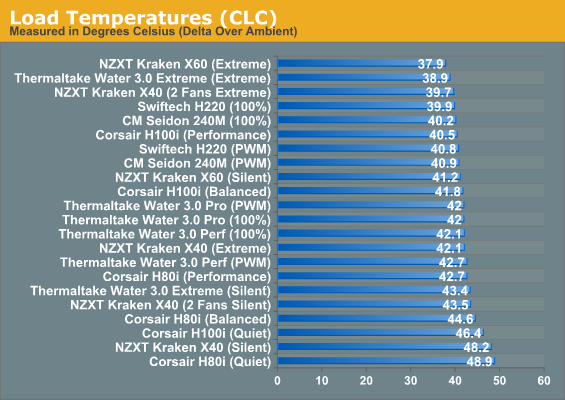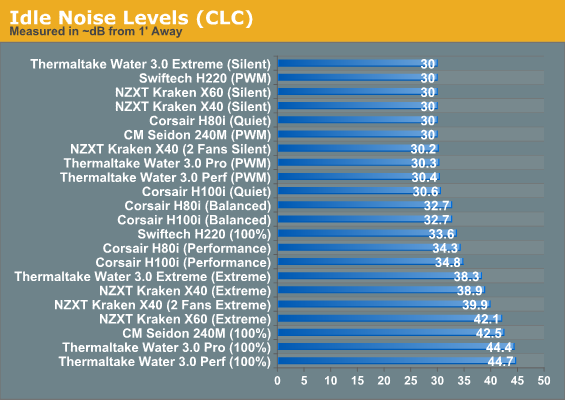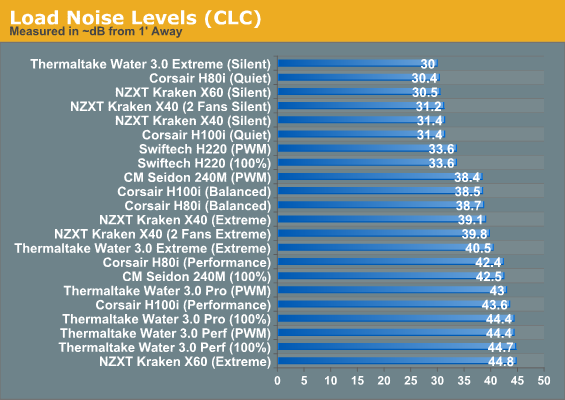Thermaltake Water 3.0 Closed Loop Cooler Roundup
by Dustin Sklavos on May 31, 2013 12:01 AM EST- Posted in
- Cases/Cooling/PSUs
- Thermaltake
- Water Cooling
Primary Test Results
These cooling roundups produce a tremendous amount of raw data, so it pays to look at the results in specific context. The three Thermaltake Water 3.0 coolers can be used to get a general idea of how Asetek's more traditional CLCs perform as well, and their maximum cooling capacity can be ascertained when we take a look at the absolute performance results later on.
Initially we'll look at what I consider the most "balanced" results for each cooler we've tested so far; these results find the optimal balance between cooling performance and acoustics. Unfortunately, because the two 120mm Water 3.0 units use the motherboard's PWM control, fan speed gets ramped up under load and you'll see they become two of the loudest kits we've tested.

First, thermals. It may seem unusual that the Water 3.0 Extreme's 240mm radiator takes last place behind its siblings, but when you look at the noise levels it produces as a result of its more sophisticated fan control, you'll see why. The results overall are essentially competitive, though; between the CoolIT-based Corsair H80i and H100i and the Asetek-based Thermaltakes you'd be hard-pressed to find too much of a difference in overall thermal performance, or at least performance potential. We can narrow that down by looking at the CLC results specifically.

Cull the bottom three "quiet" results from Corsair and NZXT and you essentially look at only a roughly seven degree delta between the least powerful and most powerful closed loop coolers. In fact, going from a 240mm to a 280mm Asetek doesn't seem to yield much of a performance advantage. When we bring noise into the equation, though, the results separate a bit.


Load noise on the 120mm Water 3.0 entrants is frankly pretty nasty. The 240mm Water 3.0 Extreme on its Silent setting acquits itself reasonably well, but its performance is near the bottom of the pack. To me, this is where the closed loop coolers in general lose some of their appeal. Swiftech's H220 does a stellar job with its copper radiator and powerful pump, and it's really the odd man out due to its comparatively low load noise.










18 Comments
View All Comments
Wetworkz - Friday, May 31, 2013 - link
I do not remember where I saw this but some guy hooked his water cooler to his toilet. No, I am not kidding. He ran plumbing to the tank on the back of the toilet and every time his temperature began to climb he would flush the toilet and get a new surge of cool water. I am pretty sure you could find the article if you wanted to look it up, it was pretty entertaining to be honest.EJ257 - Saturday, June 1, 2013 - link
That's actually pretty brilliant. Was it this guy?http://www.extremetech.com/extreme/124677-how-to-c...
jkresh - Sunday, June 2, 2013 - link
that could work depending on your usage, if you are always running at load (folding at home or something along those lines) it wouldnt help because eventually all the water would get warm (and without a radiator it would continue to heat up), but if you only run for relatively short periods of time (lets say an hour or two for gaming) then that might work. The most impressive system I saw, was someone ran a a server farm in his basement, with water running outside to copper pipes which ran deep under his yard, so he basically used geothermal cooling for his computers, kind of a crazy setup, but using the Earth as your heatsink has its advantages.Adamantine - Friday, May 31, 2013 - link
You didn't setup the radiator like people who do full PC liquid cooling setups do, which is going to perform better than how you did it. Fans need to be setup as intakes on the radiator, not exhaust. It almost guarantees the radiator will get the coolest air possible which isn't possible when setup as exhaust.dwade123 - Friday, May 31, 2013 - link
They should start making those compatible with CPU & GPU. Now that is truly a All-in-One design.Galcobar - Friday, May 31, 2013 - link
Copyediting error in the second paragraph of the first page."The variety of coolers is pretty simple: you're dealing with a traditional 120mm radiator in the Water 3.0 Pro, you get a double-thick 120mm radiator with the Water 3.0 Pro, and then you go back to standard thickness and double-length with the 240mm radiator in the Water 3.0 Extreme."
That first "Pro" should be "Performer."
vishwa108 - Saturday, June 1, 2013 - link
Whilst being prejudical is an unwelcome trait, being prejudicial on behalf of Truth is an asset all men strive for. Truth be told, "Thermaltake" might sound both Tojo-ish and English, but as all know, this beastie is but a mere pretender to "watercooling", mediocrity being its forte when it comes to watercooling. Not when "Asetek" is supporting one's watercooled butt, that is. After some Bavarian ariy-fairyness having levelled Ten on the religiosity crapola. That is what you'll get for mixing Taiwanese panda greeny-loony cutieness with sophisticated Western gender-bending taste.Even so, DNA being thicker than water, the same nonsense prevailed. LOUD and LOUDER. What is "entry-level" watercooling if it is not about lowering loudness? What? Eets about pandering to fairies and their pirouettes? This has to be some Choseness Frivolity & Nonsense masquerading as Sense & Sensibility. It looks like fashion has finally caught up with PC, Performance and Overclocking. Either that or the fairies have accidentally beached themselves on the PC Cloud Cuckooland. C'mon chuck, give us the other one will ya.
xaml - Sunday, June 2, 2013 - link
What is this, if not an attempt at pooetry? Is it that your head case is the one thing in urgent need of water cooling? Thermal it. Take!